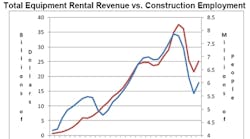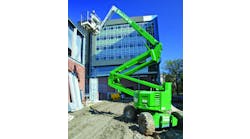The equipment rental industry finally reached bottom in 2010 at approximately $21.5 billion. We are forecasting the total rental market for construction, earthmoving and access equipment will grow by 17 percent in 2011 to approximately $25.2 billion. We estimate the market peaked in 2007 at $37.6 billion. The peak to trough decline of more than 33 percent was devastating to the companies that participate in the market.
Rental companies are quick to point out that non-residential construction activity is key to their business. Non-res, as it's called, usually lags other construction activity. For example, housing starts recovered in 2010 but didn't affect equipment rentals while non-res continued to decline and did have a negative impact on the market. Non-res construction has declined for two years — down 14.3 percent 2009 versus 2008 and down 10.9 percent from 2009 to 2010.
We have found that construction employment is a more reliable indicator of rental activity and more highly correlated (r2 = .93). Construction employment peaked in 2006 at nearly 8 million people. The trough in 2010 was 5.6 million. We expect a construction employment gain this year of approximately 7 percent, which should have a multiplier effect for equipment rentals that will result in a 17-percent gain.
Rental revenues of the largest rental companies have finally reached bottom. As of this writing fourth-quarter results are not available. We've compared the third quarters for 2009 through 2010.
Profit margins as measured by EBITDA appear to have hit bottom. We expect a recovery in profitability as well.
The decline in rental revenues appears to be slowing:
Fleet utilization is improving and/or has stopped declining:
The increase in fleet utilization is partly a function of the rental companies aging their fleets. The major rental companies have newer fleets than the rental industry in general. According to Rouse Asset Services the average fleet age for all rental companies was 52.8 months as of December 2010.
Rental companies have managed their business by reducing the size of their fleets and by reducing the quantity of branch locations they operate. The only exception seems to be Ahern Rentals, which until a year ago was highly dependent on the Las Vegas market for a substantial portion of its rental revenues. Ahern opened a relatively large number of branches over the past three years and redeployed its fleet assets to markets that had more potential for them.
Capital expenditures for new equipment are stilling to increase. Equipment manufacturers have certainly benefited in 2010 from re-fleeting by national rental companies as well as their distributors.
The decline in rental rates is slowing, except for the crane business, which should help rental companies improve their profitability.
Rental company margins have stabilized, albeit at a low level.
Generally it appears that the major rental companies have managed their way through the downturn very nicely. Prudent management has allowed them to sustain their operations through the downturn. Actions taken recently included slashing of fleet assets, reducing the number of branch locations operated and more recently redeployment of assets to fit their business into the new “normal” market conditions and a shift of rentals toward earth-moving equipment from the extreme fleet bias towards access equipment.
Most of the national rental companies have reported annual losses for the past three years and the shareholder equity for a number of them has been negative and declined. As long as shareholders and lenders are willing to let management of these companies work through their problems the industry will recover without more consolidation than we have already experienced.
We have published the following table for the past 10 years. It represents our estimate of total rental revenues based on our analysis of the quantity of rental outlets and average revenues per outlet. We believe it is a fair and accurate portrayal of U.S. rentals of construction, mining and access equipment. It does not include other general rental categories.
Frank Manfredi is president of Mandelein, Ill.-based Manfredi & Associates, a marketing information firm that specializes in the construction, mining, farm and material-handling equipment industries. Visit www.machineryoutlook.com.














